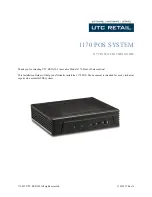
59
Chapter 12: ISDN TA/V Configurations
12.4 Creating a User-Defined Configuration
Where the operating requirements of the remote ISDN TA/V, to which you
want to establish a connection, differ from those provided by any of the
factory-set configurations, you can create and store a user-defined
configuration expressly for use when communicating with that remote
Terminal Adator. Two such user configuration locations are provided for
in your ISDN TA/V’s memory, namely User 1 and User 2.
A user configuration is created by altering the parameter settings of the active
configuration, and then saving this altered configuration into one of the two
locations provided. The AT commands used to alter an ISDN TA/V’s
configuration are listed in
Appendix B
, how to use them and the significance
of each value is explained in the remaining chapters of this manual.
12.4.1 B
UILDING A
U
SER
-D
EFINED
C
ONFIGURATION
Having established a link between your computer and the ISDN TA/V, and
using either your communications software program, the
Intro
software, or a
terminal attached to the
CONTROL
port — load the factory configuration
which most closely resembles your requirements as the active configuration
(following the instructions given in
Section 12.2
). Then type the AT
commands required to alter the configuration.
For example, if you want to use Factory 0 but want to turn the autoanswer
facility of, load Factory 0, then type
ATS0=0<CR>
, where
S0=0
disables the
autoanswer facility. All parameters and S-Register settings that have not been
altered will match those of the original configuration (Factory 0).
Note that the active configuration will not be saved to the ISDN TA/V’s
memory unless you expressly do so as explained in
Section 12.5
.
12.4.2 S
AVING
A
LTERED
C
ONFIGURATIONS TO A
U
SER
L
OCATION
To save the active configuration to one of the two user locations, use the
&W
command as shown below:
AT&W1<CR>
Stores the active configuration in User 1.
AT&W2<CR>
Stores the active configuration in User 2.
















































